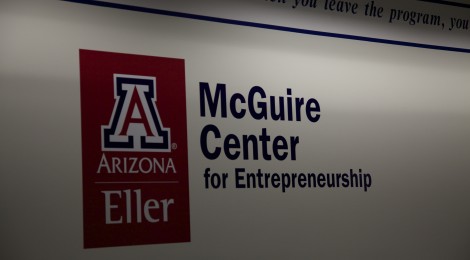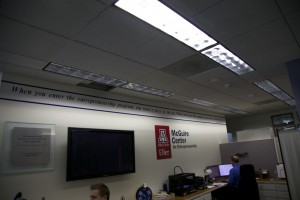
Not a Just a Piece of the Pie
The McGuire Center for Entrepreneurship at the University of Arizona is known and regarded as one of the foremost programs in Entrepreneurship Education in the country, so when we took the afternoon to sit down with the director of the McGuire Program, Dr. Patty Sias, it was a great opportunity to dig into the roots of entrepreneurship.
The McGuire Program is an intensive entrepreneurship capstone experience for undergraduate seniors and graduate students. In very basic terms, students apply to be considered for the program at the beginning of their senior. Following application decisions, the students are tasked with forming business teams that bring together other students with varied experience and expertise to identify and begin work on a viable venture. Together, the students begin very basic development of their idea to prove that it is financially and technically feasible, marketable, and compelling. From this step, the teams give intro pitches to the faculty involved with the program and are paired with a serial entrepreneur mentor who advises their venture development for the remainder of the year. Working closely with their team and mentor, the students develop their venture and become fluent in their product or service, leading up to a series of presentations. Teams have the opportunity to present at business plan competitions around the country, but their real final test is Innovation Day, where they present their ventures to their peers, faculty, investors, politicians, and the media on campus.
The McGuire Program is a beast. In the course of 9 months, the students will create, develop, pitch, and in some cases, launch complete ventures. They perform all the market research, develop a product, and communicate it to investors. Students in the McGuire Program essentially have the opportunity to start a business in a supportive environment with resources and experts at their disposal. What’s more, the launch rate of ventures developed in the program is nearly 30%, above the national average. Examples of these ventures include Notehall (now Chegg), an online platform for sharing notes between students, and Grafted Growers, a system of agriculture that enables farmers to grow crops with less land, water, and no fertilizers or pesticides.
So many features of the program stuck out to me, but I was particularly struck by the primary objective of the McGuire Program. At the conclusion of the program, students should be able to see problems and not walk away. After nine months of intensive research, creativity, and teamwork, students who complete the McGuire Program will have learned how to identify problems and develop viable solutions through launching a venture. Effectively, the students who graduate from the program will have applied the skills they accumulate over four years to a real world problem, they will have practiced engaged, global citizenship.
I was immediately struck by how similar this outcome was to the aspirations of Dickinson’s liberal education. Dr. Benjamin Rush, Dickinson’s revolutionary founder, was an entrepreneur himself. In the 18th century, he identified a problem that our new nation would face. He understood that citizenship in our new democracy required a new education, thus he founded Dickinson on the premise of equipping students with a useful education. He identified a problem and developed a solution.
Today, our aim is still the same. Dickinson focuses on equipping students with a useful education in order to produce graduates who are global citizens. Dickinson students are challenged to engage real world problems in classroom discussion, global study, and research, and in the last decade, we have adopted sustainability as a core value and competency. We have been thinking and talking about global climate change, natural resource depletion, population growth, urbanization, global poverty, and globalization in our classrooms, and we have been researching solutions in the field, abroad, and in the laboratories of Rector Science Complex. It seems natural that Dickinson’s next step would be to begin engaging students in practicing solutions.

When you walk into the McGuire Center’s office, the wall behind the reception desk displays a quote: “When you enter the entrepreneurship program, you want a piece of the pie. When you leave the entrepreneurship program, you want to make the pie.”
The McGuire Program challenges students to put into practice the skills they have acquired at the University of Arizona. They are challenged to identify a problem and propose a solution, and once they get a taste of the entrepreneurial spirit, they’ll want more. The McGuire Program succeeds in engaging its students in global citizenry, even if a venture never launches or investors never show up to the party.
When thinking about entrepreneurship education at Dickinson, an experiential learning component would be authentic to the spirit of our institution, and would be a meaningful experience for students; a way of getting ideas off the shelves and into student hands, to really engage the world.